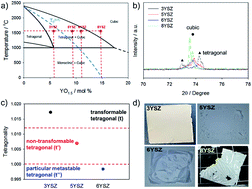Next-generation flexible solid oxide fuel cells with high thermomechanical stability†
Abstract
Solid oxide cells (SOCs) convert chemical energy into electrical energy at high temperature with very high energy efficiency and fuel flexibility. However, repeated redox and thermal cycles in harsh environments cause mechanical deformation or crack formation under pressure derived from SOCs stacked up. Flexible ceramic components can provide SOCs with thermomechanical shock tolerance to relieve such stress and to achieve long-lasting operation. Here, a next-generation flexible SOC (F-SOC) with a bendable 3 mol% yttria-stabilized zirconia (3YSZ) electrolyte is carefully controlled by the composition-dependent phase transition, grain size, and surface roughness. Furthermore, the cell production includes simple and cost-effective techniques including tape-casting, screen-printing, and co-firing processes, ensuring its reproducibility. The F-SOC fulfills noteworthy 4.27% degradation in on–off cycles for 500 h, producing a reasonable power output. The results described here can establish a foundation towards next-generation flexible SOCs with thermomechanical shock resistance, and they could be applied in various research fields such as photovoltaics, flexible electronics, and sensors.



 Please wait while we load your content...
Please wait while we load your content...